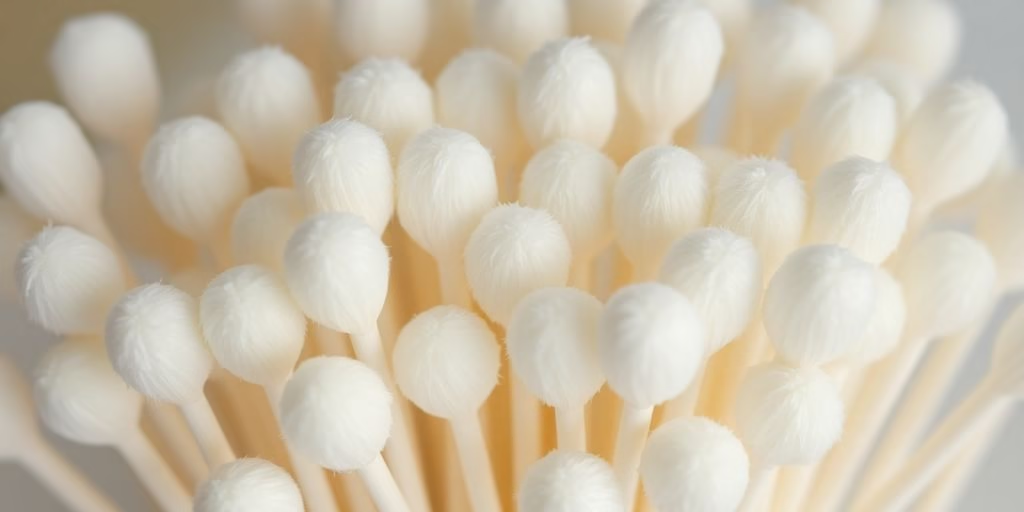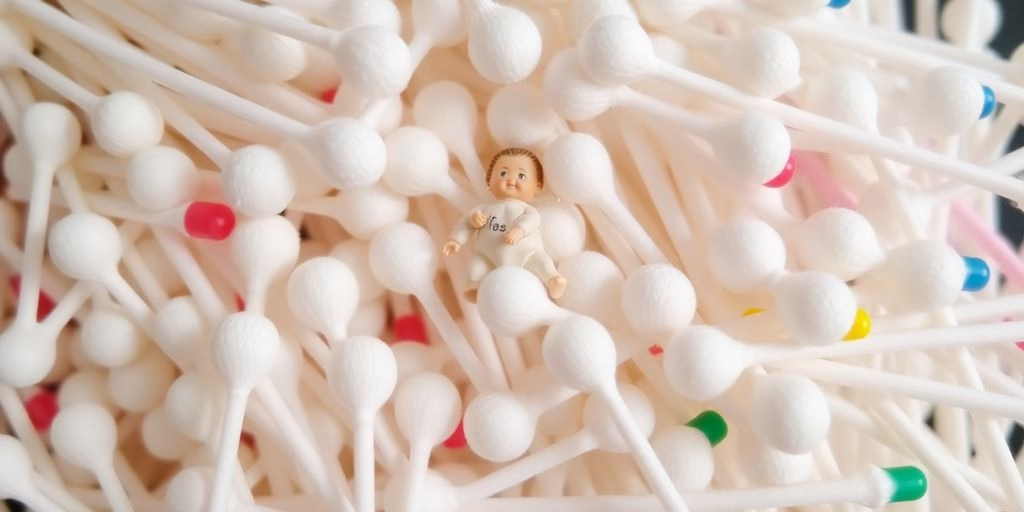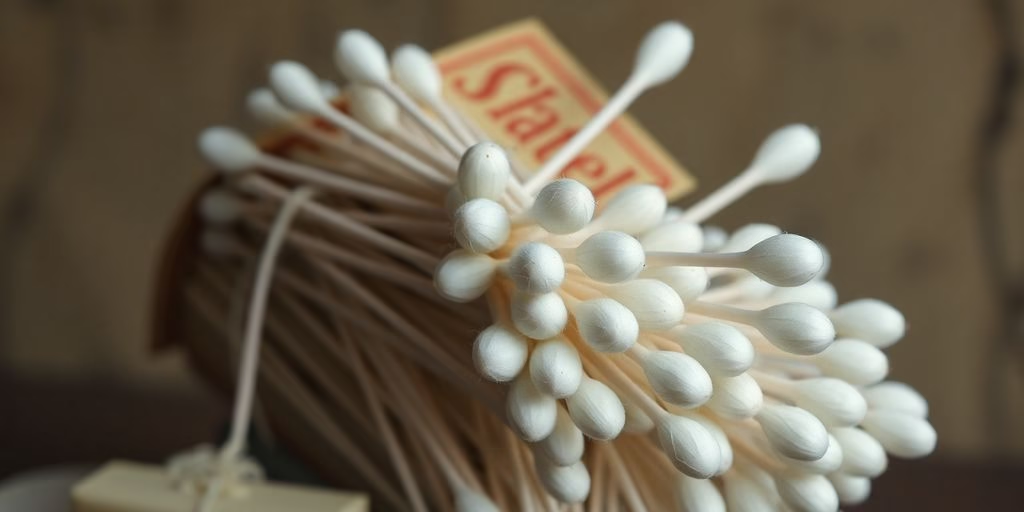Have you ever stopped to think about those little cotton swabs we all use? They seem so simple, right? But where did they even come from? Turns out, the story behind them is pretty interesting, starting with a dad trying to make life easier for his baby. We’re going to look at how these handy little tools, from their early days as a baby gays product to what we use today, got their names and how they’ve changed over time.
Key Takeaways
- The cotton swab was invented by Leo Gerstenzang in 1923, initially named ‘Baby Gays,’ to help clean his baby.
- The brand name evolved to ‘Q-tips Baby Gays’ and then simply ‘Q-tips,’ with ‘Q’ standing for quality.
- Cotton swabs are known by different names globally, such as ‘cotton buds’ in the UK and ‘menbō’ in Japan.
- Over time, the design has shifted from wooden sticks to plastic, and more recently, to eco-friendly materials like bamboo and paper.
- Today, cotton swabs are made for many uses, from delicate cosmetic applications to industrial needs, with specialized designs and materials available.
The Genesis of the Cotton Swab
From Toothpicks to Innovation: Leo Gerstenzang’s Vision
It’s funny how some of the most common items we use every day started with a simple observation. Take cotton swabs, for instance. Before they were a standard bathroom fixture, the idea of a convenient, hygienic way to clean delicate areas was still forming. This is where Leo Gerstenzang comes into the picture. He was a Polish immigrant living in the United States, and like many parents back in the 1920s, he noticed his wife trying to clean their baby’s ears and other small crevices. Her method? Wrapping bits of cotton around the end of a toothpick. It worked, sort of, but it wasn’t exactly ideal. The cotton could slip off, and toothpicks aren’t exactly designed for gentle, precise cleaning. Leo saw this makeshift solution and thought, “There has to be a better way.” He envisioned a product that was purpose-built for this task, something safe, effective, and easy to use. His goal was to create a standardized, reliable tool for baby care.
The Birth of ‘Baby Gays’: A Father’s Ingenuity
Leo Gerstenzang didn’t just have the idea; he actually went and made it happen. Around 1923, he developed a prototype: a small wooden stick with soft cotton securely attached to both ends. This wasn’t just about convenience; it was about safety and hygiene for infants. He wanted to offer parents a product that was far superior to the toothpick-and-cotton method. He launched his invention, and he initially called it “Baby Gays.” It was a name that reflected its primary intended use – caring for babies. This was a significant step, moving from a DIY fix to a manufactured product designed with a specific purpose in mind. It was a clever bit of fatherly ingenuity that would soon change how people approached delicate cleaning tasks.
From Baby Care to Household Staple
Once Leo Gerstenzang introduced “Baby Gays,” the product quickly found its footing. While it was initially marketed with babies in mind – think cleaning little ears, noses, and other sensitive spots – people soon realized its usefulness extended far beyond the nursery. Its small size and the soft, absorbent cotton made it perfect for all sorts of tasks. Applying makeup, touching up nail polish, cleaning small electronics, or even tending to minor cuts became easier with this handy little tool. It was a classic case of a product designed for one need finding a much broader application. What started as a specialized item for infant care gradually became a common household item, proving its versatility and earning a permanent place in medicine cabinets and makeup bags everywhere.
The Evolution of a Name
When Leo Gerstenzang first came up with his brilliant idea for a better way to clean babies’ ears and other delicate areas, he called them “Baby Gays.” It was a nod to their intended use for infants and perhaps a bit of a playful, affectionate term. But as the product started gaining traction beyond just baby care, the name began to feel a little… limiting. Plus, let’s be honest, “Baby Gays” might raise an eyebrow or two in today’s world.
The ‘Q’ for Quality: Introducing Q-tips Baby Gays
Recognizing the need for a name that conveyed a sense of superiority and reliability, the company introduced a new moniker: “Q-tips Baby Gays.” The “Q” was added to stand for quality. This was a smart move, signaling that these weren’t just any cotton swabs, but ones made with a higher standard. It was a way to differentiate them in the market and build trust with consumers who wanted the best for their little ones. The addition of “Q-tips” alongside “Baby Gays” was a transitional phase, bridging the gap between the original affectionate name and a more universally appealing brand.
Simplification to Q-tips: A Brand is Born
As the product’s popularity grew and its uses expanded far beyond just baby care – think makeup application, cleaning electronics, and all sorts of household tasks – the “Baby Gays” part of the name started to feel a bit out of place. It was too specific and didn’t capture the broad appeal of the product. So, in a move that would solidify its place in households everywhere, the name was simplified to just “Q-tips.” This streamlined name was catchy, easy to remember, and the “Q” for quality remained, now representing the brand as a whole.
Understanding the ‘Q’: More Than Just a Letter
The “Q” in Q-tips has always been more than just a letter; it’s a promise. It signifies a commitment to high standards in manufacturing, from the tightly wound cotton tips to the sturdy, splinter-free sticks. While the original intent was to highlight quality, the name has come to represent reliability and precision in a wide array of applications. It’s a simple yet powerful identifier that has helped Q-tips become the go-to brand for cotton swabs, a testament to how a well-chosen name can truly define a product’s identity and market success.
Global Variations in Terminology

It’s pretty fascinating how a simple item like a cotton swab can have so many different names depending on where you are in the world. What we might call a “cotton swab” here in the US is known by entirely different terms across the pond or even in neighboring countries. It really highlights how language evolves and how products get adopted into different cultures.
Cotton Buds Across the Commonwealth
If you head over to the United Kingdom, Australia, New Zealand, or many other Commonwealth nations, you’re likely to ask for “cotton buds.” This term seems to be the standard there, and it’s a pretty straightforward description of what the item is – a bud of cotton on a stick. It’s a simple, descriptive name that makes sense, right?
Swabs and Q-tips in North America
In the United States and Canada, “cotton swab” is the most common generic term. However, the brand name “Q-tips” has become so popular that it’s often used interchangeably with the generic term, much like how “Kleenex” is used for tissues. It’s a testament to the brand’s strong market presence over the years. You’ll find both terms used frequently in everyday conversation and in stores.
International Nomenclature: From Menbō to Cotons-tiges
But the variations don’t stop there. Travel a bit further, and you’ll encounter even more unique names. In Japan, for instance, they are called “menbō” (綿棒), which literally translates to “cotton stick.” Germany uses “Wattestäbchen,” also meaning “cotton stick.” France has “cotons-tiges,” translating to “cotton stems.” Italy often uses “Cotton Fioc,” another brand name that became generic. Spain calls them “bastoncillos de algodón,” or “cotton sticks.” It’s a whole linguistic world tour for a simple product!
Here’s a quick rundown:
| Region/Country | Common Term(s) |
|---|---|
| UK, Australia, etc. | Cotton buds |
| USA, Canada | Cotton swabs, Q-tips |
| Japan | Menbō (綿棒) |
| Germany | Wattestäbchen |
| France | Cotons-tiges |
| Italy | Cotton Fioc |
| Spain | Bastoncillos de algodón |
This global diversity in naming really shows how a product can become integrated into daily life in different ways. It’s a small but interesting piece of how we communicate about the things we use every day. For more on the journey of these handy items, you can check out this guide to cotton swabs history.
Design and Material Transformations
The humble cotton swab, a fixture in bathrooms and first-aid kits worldwide, hasn’t always looked or felt the way it does today. Its journey from a simple concept to a ubiquitous household item is a story of material evolution and thoughtful design tweaks.
The Early Days: Wooden Sticks and Cotton
When Leo Gerstenzang first envisioned a better way to clean a baby’s ears, his initial prototypes were quite straightforward. He attached small tufts of cotton to the ends of thin wooden sticks. These early versions were functional, offering a gentler alternative to the often-sharp toothpicks people were using. The wood provided a decent amount of rigidity, allowing for some control, but it wasn’t always the most comfortable or consistent material. Sometimes the cotton would unravel, or the wood might splinter slightly. Still, it was a significant step up in safety and gentleness for baby care.
The Rise of Plastic: Flexibility and Affordability
As manufacturing techniques advanced, plastic emerged as a game-changer for cotton swab production. Plastic sticks offered a new level of flexibility and durability that wood couldn’t match. They were less prone to splintering and could be molded into various shapes and thicknesses. This material also proved to be incredibly cost-effective to produce in large quantities. The bendability of plastic sticks made them ideal for reaching awkward spots, whether for personal grooming or more delicate tasks. This shift towards plastic also paved the way for mass production, making cotton swabs more accessible and affordable for everyday consumers.
Sustainable Shifts: Paper, Bamboo, and Beyond
In recent years, there’s been a growing awareness of the environmental impact of single-use plastics. This has led to a significant push for more sustainable alternatives in cotton swab design. Manufacturers are now experimenting with and widely adopting materials like:
- Paper: Often made from recycled paper or sustainably sourced pulp, paper sticks offer a biodegradable option. They can be a bit less rigid than plastic, but advancements are improving their strength.
- Bamboo: A rapidly renewable resource, bamboo is naturally strong and biodegradable. Bamboo sticks offer a good balance of rigidity and environmental friendliness.
- Wood: While early versions used wood, modern wooden sticks are often made from sustainably managed forests, providing a sturdy and compostable choice.
These shifts aren’t just about the sticks, either. Packaging is also evolving, with more brands opting for recyclable cardboard or compostable materials to reduce waste. It’s a clear sign that consumers are looking for products that align with their environmental values, and the industry is responding.
Specialized Applications Emerge
It’s pretty wild how something as simple as a cotton swab has branched out into so many different uses, right? Beyond just cleaning ears or touching up makeup, these little tools have become surprisingly specialized. Think about it – you wouldn’t use the same swab for applying a delicate eyeliner wing as you would for cleaning out a tiny electronic component. Manufacturers have really leaned into this, creating specific designs for all sorts of tasks.
Precision Tips for Delicate Tasks
For those moments when you need to be super precise, like with intricate makeup application or cleaning small electronics, there are swabs designed just for that. These often have much smaller, more densely packed cotton tips. They’re made to be firm enough to hold their shape and not leave behind any stray fibers. It’s all about control and accuracy, making sure you can hit that tiny spot without messing up anything else.
Cosmetic Colors and Baby Care Gentleness
In the beauty world, you’ll find swabs in all sorts of colors, sometimes even with different tip shapes to help with specific makeup techniques. Then there’s the baby care side of things. These swabs are usually made with extra-soft cotton and have rounded tips, specifically designed to be gentle on a baby’s sensitive skin. It’s a thoughtful touch, recognizing that different users have different needs and sensitivities.
Industrial Uses and Medical-Grade Standards
And it doesn’t stop there. You’ve got industrial-grade swabs used for cleaning sensitive equipment in factories or labs. These often meet strict medical standards, meaning they’re sterile and made with materials that won’t contaminate anything. They’re built for reliability in environments where even a tiny bit of dust or a stray fiber could cause a big problem. It really shows how versatile the humble cotton swab has become.
Choosing the Right Cotton Swab

So, you’ve got your Q-tips, or maybe some generic cotton buds, and you’re ready to tackle… well, whatever it is you need them for. But have you ever stopped to think if you’re using the right ones? It sounds simple, but with all the options out there now, it’s actually a bit more involved than you might think. From the stick material to the tip shape, each little detail can make a difference in how well they work for your specific task.
Material Matters: Plastic vs. Biodegradable Sticks
Remember when almost all cotton swabs had plastic sticks? They were flexible, cheap, and readily available. But as we all know, plastic sticks stick around in the environment for a very, very long time. That’s why there’s been a big push towards more eco-friendly options. You’ll find sticks made from paper, bamboo, and even wood pulp now. Paper sticks can sometimes feel a bit less sturdy, especially if they get wet, and bamboo or wood sticks offer a nice, rigid feel for more control. It really comes down to what you prioritize: flexibility and familiarity, or environmental impact.
Tip Design: From Softness to Precision
This is where things get really interesting. Cotton swab tips aren’t just generic puffs of cotton anymore. For delicate tasks like applying makeup or cleaning tiny electronics, you might want a swab with a really fine, pointed tip. These are great for getting into small crevices or making precise corrections. On the other hand, if you’re using them for general cleaning or applying a product to a larger area, a standard, rounded tip with a bit more cotton might be better. Some even have different tip shapes on each end for added versatility.
Here’s a quick rundown:
- Standard Round Tip: Good for general cleaning and applying products.
- Pointed Tip: Ideal for detailed work, makeup corrections, and reaching tight spots.
- Flat/Paddle Tip: Useful for applying or blending makeup, especially eyeshadow.
- Extra-Fluffy Tip: Offers more absorbency and coverage for certain applications.
Identifying Quality: What to Look For
When you’re picking out cotton swabs, what separates a good one from a not-so-good one? For starters, check out the cotton itself. You don’t want a swab where the cotton is loosely wound and likely to fall off or leave little fibers behind, especially if you’re using them for personal care or cleaning sensitive items. Tightly wound, pharmaceutical-grade cotton is usually a sign of a higher-quality product. Also, consider the stick – does it feel sturdy enough for your needs, or does it bend and buckle too easily? Packaging is another clue; individually wrapped swabs are best for medical or sterile uses, while resealable containers keep the rest clean for everyday use.
Sometimes, the simplest products have the most thought put into their design. It’s worth taking a moment to consider how a small change, like the material of the stick or the shape of the tip, can make a big difference in how you use it and its impact on the world around you. It’s not just about grabbing the cheapest pack anymore; it’s about making a choice that works for you and the planet.
Ultimately, the best cotton swab for you depends on what you’re using it for. Are you a makeup artist needing precision? A parent cleaning a baby’s ears (gently, on the outside!)? Or just someone who needs to dust off a keyboard? Knowing your needs will help you pick the perfect little tool for the job.
From Baby Gays to Q-tips: A Tiny Tool’s Big Journey
So, there you have it. That little cotton swab you probably have lying around your bathroom? It’s got a surprisingly interesting past. It started with a dad trying to make bath time easier for his baby, and now it’s a household staple used for everything from makeup touch-ups to cleaning out your keyboard. It’s funny how things change, right? The name even went through a few versions before landing on Q-tips, which, by the way, stands for quality. It just goes to show that even the simplest items have a story, and sometimes, those stories start with a simple need and a bit of clever thinking.
Frequently Asked Questions
Who invented cotton swabs, and why?
Back in the 1920s, a dad named Leo Gerstenzang saw his wife using toothpicks with cotton on the end to clean their baby. He thought there had to be a better, safer way. So, he invented a cotton swab with cotton safely stuck to both ends of a wooden stick. He first called them ‘Baby Gays’!
Why are they called Q-tips, and what does the ‘Q’ mean?
The name changed a few times! First, it became ‘Q-tips Baby Gays,’ where ‘Q’ stood for ‘Quality.’ Later, they dropped ‘Baby Gays’ and just called them ‘Q-tips.’ The name stuck because it sounded good and meant the product was high quality.
Do cotton swabs have different names in other countries?
Yes, they have different names in different places! In places like the UK and Australia, people often call them ‘cotton buds.’ In Japan, they’re known as ‘cotton sticks’ or ‘menbō.’ France uses ‘cotons-tiges,’ which means ‘cotton stems.’
What have cotton swabs been made of over the years?
Originally, they were made with wooden sticks. But over time, plastic became popular because it was cheaper and more flexible. Now, people are looking for more eco-friendly options, so you can find them with sticks made of paper, bamboo, or even wood.
Are there different kinds of cotton swabs for different jobs?
While the basic cotton swab is great for many things, there are now special ones. You can find ones with tiny tips for very precise work, like applying makeup around your eyes. There are also softer ones made especially for babies, and even ones used in factories or labs for cleaning tiny parts.
How can I choose the best cotton swab for myself?
Think about what you’ll use them for. If you need to be really careful, a precision tip might be best. If you care about the environment, look for ones with paper or bamboo sticks instead of plastic. Always check that the cotton is attached well and the stick isn’t rough.





Leave a Reply